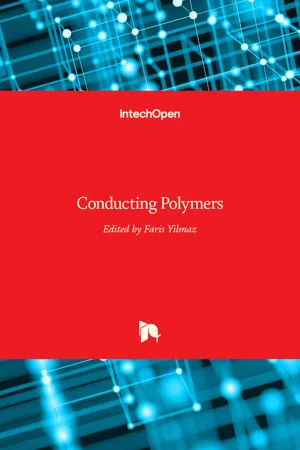
- 266 pages
- English
- PDF
- Available on iOS & Android
Conducting Polymers
About This Book
An authentic revolution took place in the area of solid-state chemistry and physics just after World War II. The century of solid state started from the modest beginnings of the transistor at Bell Laboratory. Since then, the area of science and technology has been directed primarily toward the study of alloys, ceramics, and inorganic semiconductors. The size of electronic devices became smaller and smaller, while the dimensionality of materials was also reduced just after the invention of the integrated circuit. It is at this point that the advent of the discovery of quasi one-dimensional conductors has opened up a whole new area of ''nonclassical'' solid-state chemistry and physics. In the modern world, plastic and electrical devices are always tightly integrated together. However, it was in 1977 that an electrically conductive, quasi one-dimensional organic polymer, polyacetylene, was discovered. During the past 30 years, a variety of different conducting polymers have been developed. Excitement about these polymeric materials is evidenced by the fact that the field of conducting polymers has attracted scientists from such diverse areas of interest as synthetic chemistry, electrochemistry, solid-state physics, materials science, polymer science, electronics, and electrical engineering.
Frequently asked questions
Information
Table of contents
- Conducting Polymers
- Contents
- Preface
- Chapter 1 Conductive Polymer-Based Membranes
- Chapter 2 Conducting Polymers in Sensor Design
- Chapter 3 Conducting Polymer Aerogels
- Chapter 4 Coating of Conducting Polymers on Natural Cellulosic Fibers
- Chapter 5 Space Charge–Limited Current Model for Polymers
- Chapter 6 Perspectives of Conductive Polymers Toward Smart Biomaterials for Tissue Engineering
- Chapter 7 Electrical Properties of Polymer Light-Emitting Devices
- Chapter 8 Properties of Metal Oxide Pigments Surface Modified with Polyaniline Phosphate and Polypyrrole Phosphate in Corrosion Protective Organic Coatings
- Chapter 9 Exfoliated Nanocomposites Based on Polyaniline and Tungsten Disulfide
- Chapter 10 Phenylenevinylene Systems: The Oligomer Approach
- Chapter 11 Intercalation of Poly(bis-(methoxyethoxyethoxy)phosphazene) into Lithium Hectorite